Imagine you own an old house. You gambled on charm, chose that claw-foot tub and rustic wood over new plumbing and boring, yet unblemished counter tops. Admittedly, that charismatic old-timer comes with your standard, endearing kinks: creaking floor boards, occasional water leaks, mystery smells, clanking and growling in the night. Like any old house, something always needs a touch-up. Your weekend to-do list grows into a fridge takeover that you swear you’ll get to the second Saturday of never.
Now imagine that charming home also doubles as your car—a slightly rusted, loyal vehicle that’s your sole mode of transportation. Now if something breaks it doesn’t make that to-do list, it swallows it whole. One problem and your house is suddenly unusable, your car and you are now immobile… Like that time we slept outside a mechanic shop in our broken-down van for over a week. That’s one of the things Instagram doesn’t tell you about #vanlife. As I’m sure you’ve already guessed, it’s not all man buns, designer coffee cups, and yoga in the sun.
As I’m sure you’ve already guessed, it’s not all man buns, designer coffee cups, and yoga in the sun.
Last year my boyfriend and I bought a 1997 Iveco camper van to travel his home country of New Zealand. I’m a strong believer that you always need to name your car, and that somehow it usually names itself. In this case Gabe’s dad, Warren, gets initial christening credit. He started calling it “The Beast” when he first drove it home for us while we were overseas. We tried to change the name, brainstormed even, but anyone who met our van declared: “Wow, that’s a Beast!” So the name stuck. Fast forward almost a year, 24,000 km (15,000 miles) of wear and tear, and the growling noises he makes huffing and puffing up hills more than fit the name.
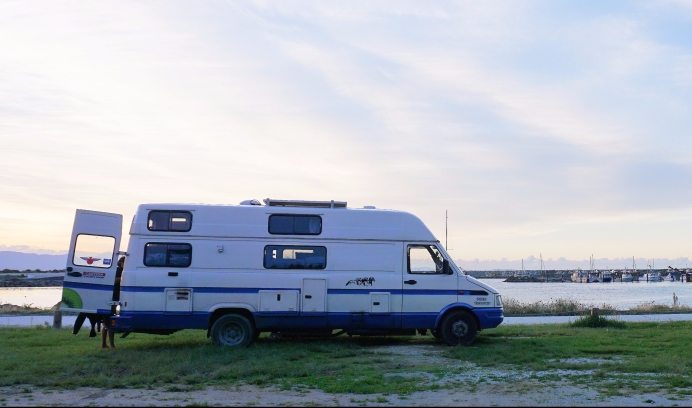
At about seven meters long and three meters high (23 ft by 10 ft) it’s closer to the size of a UPS truck than a standard family wagon. Let’s just say we wouldn’t fit through a fast food drive-through and our back end overhangs most parking spots. I stopped counting the number of times we’ve bottomed out on steep inclines with a cringe-worthy muffler scrape. The Beast is white (ish, when dirty) with blue stripes and silhouette stickers of stampeding horses on the side (blame the previous owner). We’re not at all inconspicuous. Our other bumper stickers like a giant kiwifruit (blame us) don’t help much with blending in.
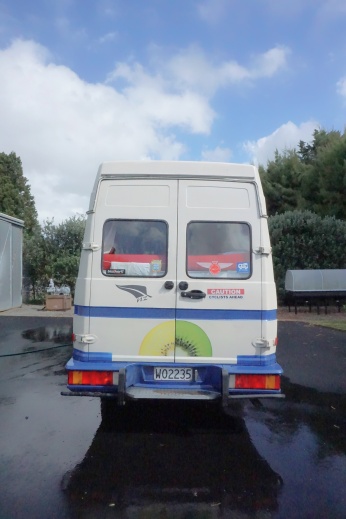
That said, Beast is actually the perfect size. He fits everything we need; a modern nomad’s dream. We have more counter space than my NYC studio—a three-burner gas stove top, small sink, couch space, a mini fridge, storage cupboards, wifi, and even an enclosed hot shower with cassette toilet. Our fixed-height bed transforms the Beast’s backside into a makeshift garage. Sometimes I feel like our steed is a cross between Mary Poppins’ magic purse and a small boat. We fit everything from two bikes to a Blokart land yacht, inflatable packraft kayaks, and spearfishing and backpacking gear. We even have those nifty cabinet locks that push in to keep the doors in place while driving. We try to keep things tidy and for the most part we run a tight ship.
Overall it’s been a fantastic seven months in the Beast, but like most travel you learn by doing and there were things I definitely didn’t see coming. Instagram tends to put a Valencia filter on life’s dirty details and #vanlife is no different. So, after 214 days of van living, here are some of the stories this latest trend in serape-covered, bohemian-fueled travel isn’t sharing. After all, knowledge is power and you should know these things if you’re considered a jump into the great four-wheeled unknown.
Indoor vs. Outdoor
In many ways camper vans epitomize indoor outdoor flow; it’s stunning to wake up in nature, doors opened to greet the day. Yet ironically, this flexibility and my favorite part of van living was the hardest adjustment to make. As humans our senses inform our perceptions of the world, with sight reigning as the king. In fact, studies show sight can actually override the other senses. In our case, we live in a car masquerading as a tiny apartment. Tucked inside with curtains closed it looks and feels like a cozy indoor lounge. That means the occasional rogue seagull crash landing on the sky vent or a sudden earthquake of wind at two a.m. can shift us a bit off-kilter. That inside feeling often clashes with the actualities of an outside existence. The key is to remember you’re really just camping with added amenities. In vanlife, as soon as you start expecting the same comfort as indoor living, subconscious unease creeps in. Adjust your expectations accordingly, remember and appreciate the reasons you chose this in the first place, and then it’s glass half full.
Vanlife means you’re fully connected to the elements. In the summer we had gloriously long days. In winter when the sun rose past nine and set before four, we did too. When it was raining, cold, or sunny, our home was damp, frozen, or radiating positivity. When the sand flies swarm like a mini vampire mob, you must accept their marks like a vanlife badge of courage. At night our breath and body heat created condensation inside the windows. We awoke one frosty morning near Arthur’s Pass to see this had completely iced over, like a lake that’s newly frozen. I’d never scraped the inside of a car’s windows before, I thought, as I blew smoke rings of crystalline air towards the van ceiling. But that’s the beauty of vanlife, it challenges you to adapt to your surroundings, heightens your awareness of the environment, and forces you to do the best thing for your mental and physical health—step outside!
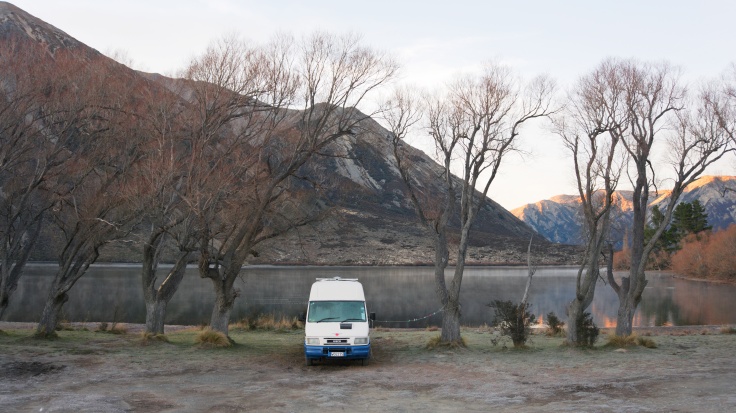
The funny thing is how #vanlife depicts this reality online. I recently stumbled upon an Instagram account of a couple touring Europe in their pop-top Volkswagen. If the girlfriend isn’t in a bikini making homemade van pizza (?!), she’s wearing summertime clothes while sitting in the back of the van with doors opened to the snowy mountains. Snuggled in a throw with a coffee cup, she looks out at the picture-perfect alps with messy hair and a contented smile as snow blankets the ground near the van tires. While I love their photography style and applaud their resolve, I can’t help but think—who are you kidding in that tank top, you must be freaking cold! It’s one thing to have snow-sprinkled mountains in a far-off backdrop, like that hilltop scene in The Sound of Music, but snow two inches from your van means it’s freezing outside. And I know those metal camping cups lose heat at an alarming rate (we have them too). This is our modern day, social media equivalent of that fake milk in cereal commercials (it looks delicious, but those Fruit Loops are actually swimming in Elmer’s Glue). If you went to that same alpine spot, you’d probably be more focused on keeping the feeling in your toes than taking in the view. And yet somehow we’d all end up with the same glamorizing photo; such is the nature of the social beast.
The Art of Van Maintenance
One thing I’m surprised doesn’t get more attention is van maintenance. This year’s New Yorker profile of vanlifers hits on this, so we can’t be alone in our fair share of mishaps. Especially here, car health is important; New Zealand requires your car pass a “Warrant of Fitness” (like a vehicle doctor’s checkup) every six to 12 months to stay on the road. Last month I finally started our own “Van Maintenance Log,” to record the amount we’ve invested in the Beast to pass these checks since we hit the highway. It took up three journal pages. Here are some of my favorites:
-
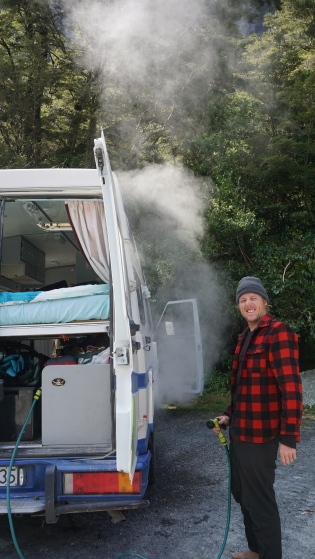
Steaming breaks detour. | Milford Sound, New Zealand The time our breaks started smoking heading into Milford Sound. Granted the last section of that two hour drive from Te Anau is about 20 km (12.5 miles) of full downhill so you can’t blame our 3.5 ton Beast for complaining.
- The time our brake pad fell out of the van. Luckily we were cruising out of a parking lot when this happened and not on open freeway. We were aware of the issue (our brakes had seized on) and headed slowly to a mechanic’s, when suddenly the van made a horrible grinding noise expelling the pad onto the cement with a clang, like a demon garbage disposal spitting out it’s prey. It was this episode that made our next campsite the mechanic’s.
- The time we froze on a hill in a campground beside Lake Pukaki during the first cold snap of the year. That night it reached -5 °C (23 °F). We awoke breathing steam to find our engine block completely iced (our antifreeze levels were too low) and a frozen mist had enveloped the south side of the van like an ice sheet. Icicles adorned the Beast like fangs, our water pipes froze and it turns out our LPG gas, which powers our stove, heater, and hot water has a mix of more butane than propane, meaning it stops converting from compressed liquid to gas below -1 °C. Who knew vanlife would double as a chemistry lesson?
- The time our muffler detached from the engine going full speed on the highway. The Beast growled so loud we had to yell to each other in the front seats. I guess he finally got his moment moonlighting as a monster truck.
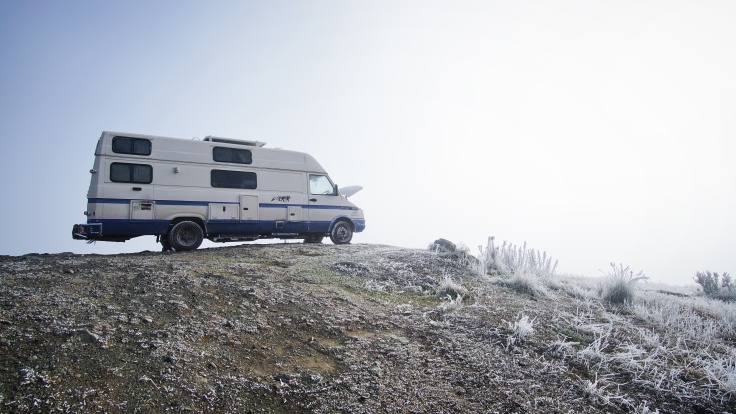
Not to mention the laundry list of inside-the-van adventures—we’ve had everything from a broken toilet, to a skink stow away, and a water leak dripping from the roof stereo speakers onto our morning bed heads. There’s also more to maintenance than just breakdowns. A quick yet ever-changing learning curve, I was surprised by how much day-to-day time is required to keep our van home happy. The big ones:
- We need battery power to keep our fridge, lights, and water pump running. Gabe installed phenomenally effective 300 watt solar panels on our roof, which meant we only had to plug in at a powered campsite twice in over seven months. However, as daylight dwindled in fall and winter we constantly nursed our power supply—driving a few km a day to charge the house batteries, plugging in our computers while doing so (anything to get the juice), and sometimes even idling in a parking lot while we worked.
- The dreaded Dump Station: We’re lucky to have a self-contained vehicle, meaning we have a kitchen sink, shower and cassette toilet and the ability to contain the grey and black water waste that comes with them. We can camp many places that ban smaller non self-contained vehicles, but it also means we have to visit a Dump Station about every three days to empty the tanks and refill with clean water. Let’s just say it’s not pretty.
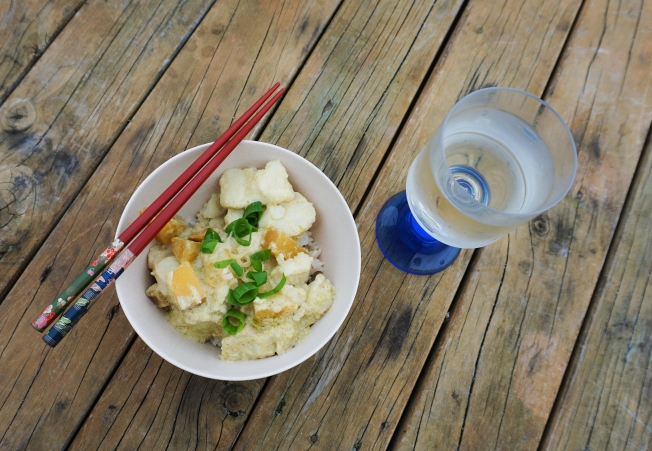
However tedious, dealing with basic necessities we used to take for granted dishes out a refreshing reality face-slap. Having to find a place to sleep each night (FYI, you can’t just park anywhere, there are regulations and designated places for campervans) makes me thankful to have a roof over our heads. In our small living space we become pungently aware of how much garbage we generate. When it doesn’t magically disappear with the trash man, we take extra care that it doesn’t pile up in our lounge. Vanlife reminds me to buy selectively, recycle, and reuse or refuse plastic (no single-use bags here, we can load our grocery shopping straight into the fridge). It made me start cooking more and actually enjoy it. We might spend just as much money as our pre-van selves, but it’s refocused on time well spent—like barista coffees, Gabe’s diving gear, airline flights, and pub nights with friends.
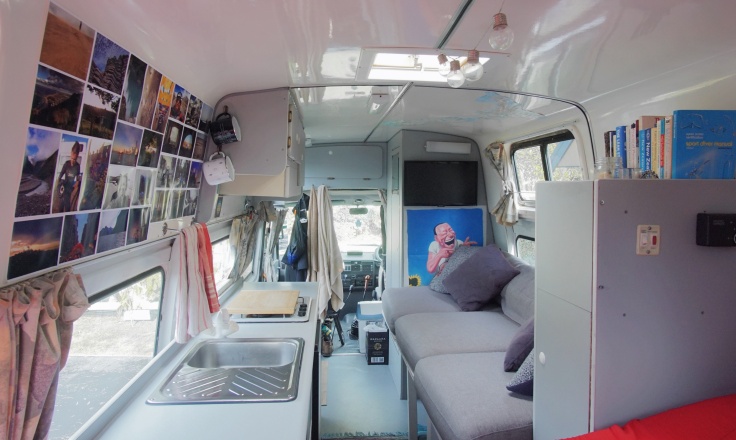
A place for everything, everything in its place.
I’ve learned to appreciate a piping hot shower after a cold run in the rain, and how to do dishes with less water than I probably used to waste brushing my teeth. Vanlife reminds me of what most of us know but choose to ignore—you don’t need that much stuff to be happy. I now understand the slogan boaties borrowed from Benjamin Franklin: “A place for everything, everything in its place.” Turns out the extra clothes, make-up and shoes I brought from New York just take up valuable space. Everyone could benefit from this possessions reset once in a while.
Solo on the Road
You’d think you would meet more people from constant travel than staying still. That’s technically true, but the connections you make are often fleeting or anchored in small talk, and especially in vanlife you may bypass them completely. Especially as the weather got colder and people moved indoors, even in a crowded campervan park most people kept to themselves. Gone were the lazy days of summer where we could bond over a shared beer under a neighbor’s makeshift awning. Gabe summed it up: “No matter where you live, you generally don’t see your neighbors every day. We’re the same and we’re always the ones who are moving away.” It’s hard to really meet people. Here in New Zealand, there are two main types of campervan travelers—young tourists in a rental van on a breakneck two-week sprint of the country, and retirees cruising in something between a motor home or a giant bus who tend to stick to the holiday parks. Age and lifestyle-wise we fell somewhere in the middle.
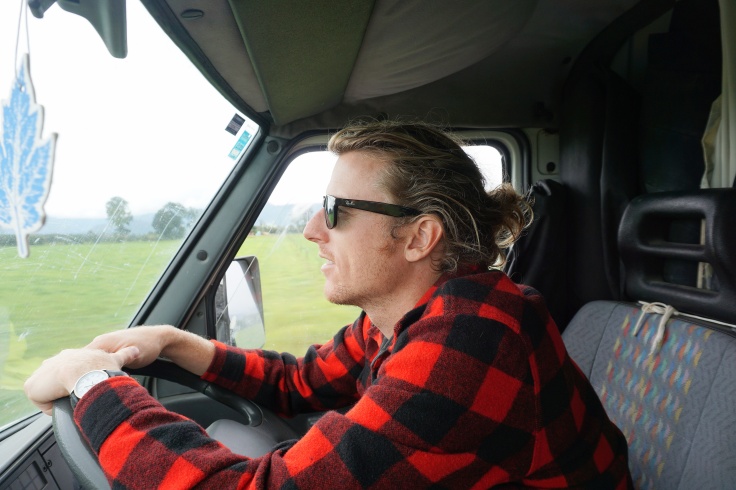
Refreshingly, once every few months we met someone with whom we’ll keep in touch, but they are too few and far between. #Vanlife portrays this aspect accurately—most photos are of lone travelers in some far-off wilderness. This makes me wonder if fittingly their most consistent social activity is the digital kind. It may sound lonely, but like any type of solo travel it actually teaches you to recognize the growth that comes through time alone, and strengthens your voice. Every time you ask someone for directions or bravely strike up a chat in the grocery line, you conquer that diffident little voice in your head that says: “Don’t talk to strangers.” For me, I’m lucky to have Gabe as my travel partner in crime and finding ways to share this lifestyle has made us a better couple.
New Zealand has also shown it’s island serendipity—several of the fantastic people we met crossed our path again. We met Amelia, a solo traveler from L.A., while walking on Stewart Island and bumped into her again in the lobby of the Interisland Ferry farther north a few weeks later. We met Kari and Jeremy, a couple newly immigrated to N.Z. and on their own tiki tour of the south, when our cars where sandwiched together in a parking lot on the coldest night of the year near Mount Cook. A month later, they recognized our van and came knocking in the Kepler car park almost 500 km away. Just like New Zealand weather, when it rains it pours.
The Truth Is
This is a fantastic way to travel. I wouldn’t chose it everywhere; just as you shouldn’t pick tacos over tortellini when in Italy, I’m sure some countries don’t cater as well as New Zealand to campervan travel. But especially here, in a country with more wilderness than residents, the ability to camp with creature comforts in remote areas is unbeatable. The freedom to travel at will and make our own schedule was an awfully nice change compared to a nine-to-five. The nature of traveling slowly, obliged us to slow down and really experience each place. The Beast didn’t allow road rage either (we couldn’t catch anyone even if we tried). Gabe says he’s become a calmer driver, and I’m a more patient traveler. Everybody wins.
#Vanlife at least gets the freedom and exploration part right, even if it hides some of the more interesting dirty laundry. I’d describe our past seven months closer to Planes, Trains and Automobiles than a photoshopped paradise, but it’s the honey and the vinegar that keep life interesting. The most telling question: Would I live in a van again? The response: YES. But maybe we’ll wait until next summer…
Happy travels,
xo SJ
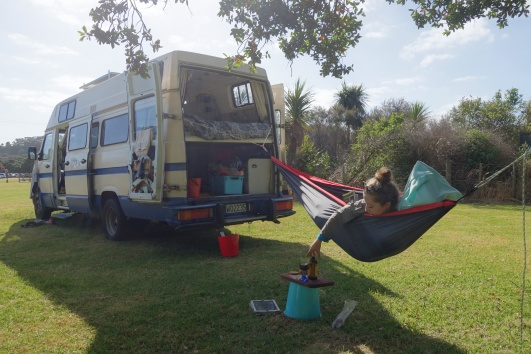
Curious? Check out another story:
- Finding Kaimoana > Catching your own New Zealand seafood
- Hiking the Old Ghost Road > A hidden gem in the New Zealand backcountry
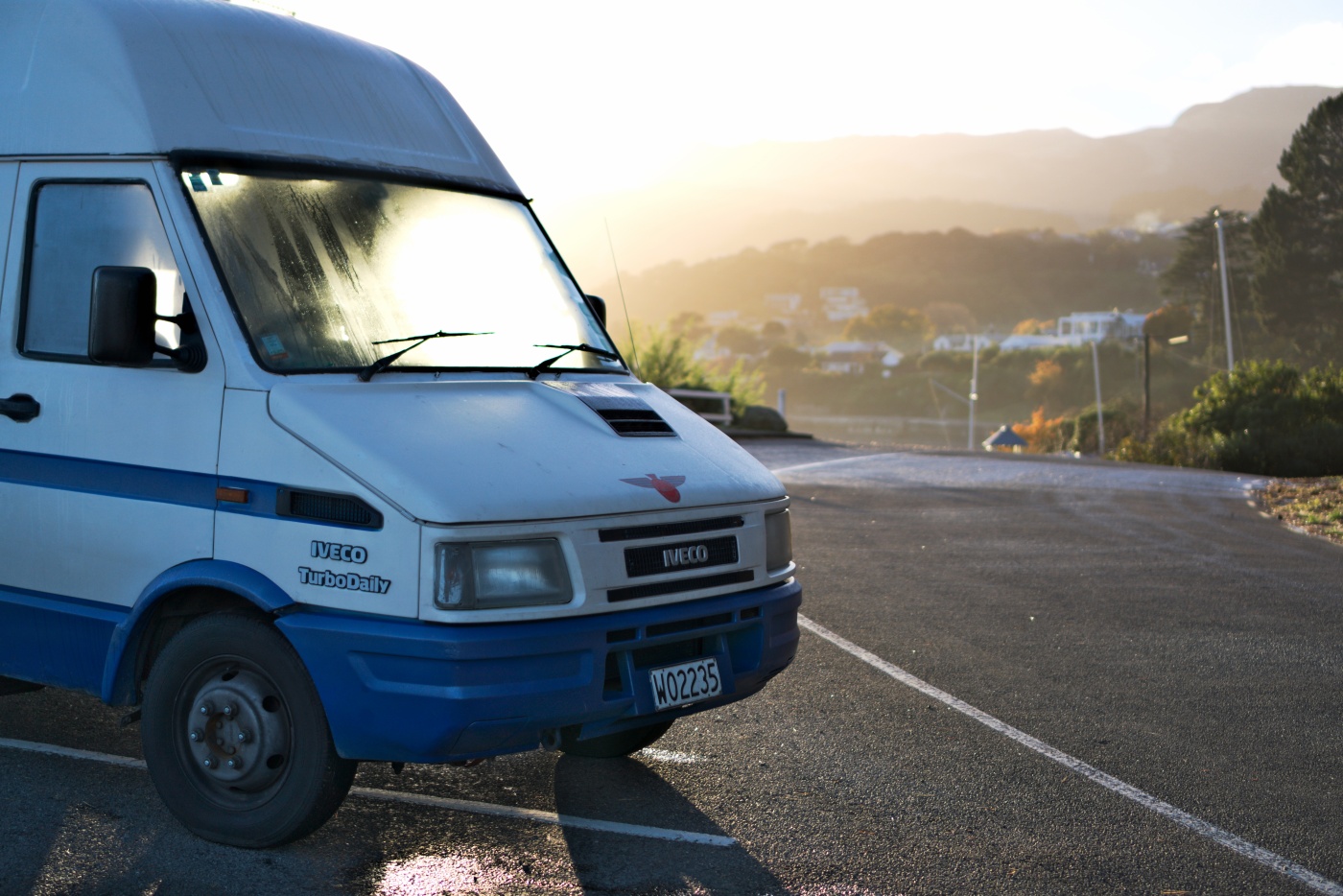
The inside of the Best looks quite spacious. 🙂
LikeLike
Darned autocorrect. I mean Beast.
LikeLike
Great read Sarah!
LikeLike
Thank you!! 🙂
LikeLike